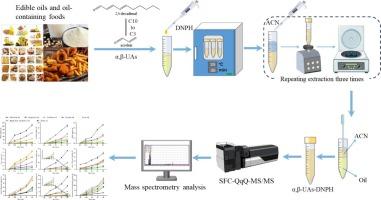Development, validation and application of an SFC-ESI-QqQ-MS/MS method for simultaneous analysis of malondialdehyde and typical α,β-unsaturated aldehydes in edible oils and oil-containing foods
IF 9.8
1区 农林科学
Q1 CHEMISTRY, APPLIED
引用次数: 0
Abstract
A novel supercritical fluid chromatography coupled with tandem mass spectrometry (SFC-ESI-QqQ-MS/MS) method was developed for simultaneous quantification of malondialdehyde (MDA) and seven α,β-unsaturated aldehydes (α,β-UAs) in edible oils and oil-containing foods. Combining DNPH derivatization with one-step extraction, the method achieved exceptional performance: linearity (R2 ≥ 0.9995), rapid analysis (16 min/sample), recoveries (85.84–106.71 %), and precision (RSD < 7.86 %), with LOD/LOQ at 0.05–0.60/0.15–1.80 μg/kg. This validated technique was subsequently applied to monitor the formation of MDA and α,β-UAs during the heating of eight edible oils, revealing concentration dependencies on fatty acid composition and heating duration. Furthermore, the levels of MDA and seven α,β-UAs in 29 oil-containing foods commonly consumed in China were determined using the developed method, with concentrations ranging from 2.65 to 326.79 μg/kg and 15.67–770.71 μg/kg, respectively. As the first SFC-based approach for comprehensive aldehyde profiling, this method enables precise monitoring of lipid oxidation pathways and supports quality control innovations in the food industry.

SFC-ESI-QqQ-MS/MS同时分析食用油和含油食品中丙二醛和典型α、β-不饱和醛的方法的建立、验证及应用
建立了同时定量食用油和含油食品中丙二醛(MDA)和7种α,β-不饱和醛(α,β-UAs)的超临界流体色谱-串联质谱(SFC-ESI-QqQ-MS/MS)方法。结合DNPH衍生化和一步提取,该方法具有良好的线性度(R2≥0.9995),快速分析(16 min/个样品),加样回收率(85.84 ~ 106.71%),精密度(RSD < 7.86%), LOD/LOQ为0.05 ~ 0.60/0.15 ~ 1.80 μg/kg。随后,该技术被应用于监测八种食用油在加热过程中MDA和α,β-UAs的形成,揭示了脂肪酸组成和加热时间对浓度的依赖性。利用该方法测定了中国常见的29种含油食品中丙二醛(MDA)和7 α,β-UAs的含量,浓度范围分别为2.65 ~ 326.79 μg/kg和15.67 ~ 770.71 μg/kg。作为第一个基于sfc的全面醛谱分析方法,该方法可以精确监测脂质氧化途径,并支持食品工业的质量控制创新。
本文章由计算机程序翻译,如有差异,请以英文原文为准。
求助全文
约1分钟内获得全文
求助全文
来源期刊

Food Chemistry
工程技术-食品科技
CiteScore
16.30
自引率
10.20%
发文量
3130
审稿时长
122 days
期刊介绍:
Food Chemistry publishes original research papers dealing with the advancement of the chemistry and biochemistry of foods or the analytical methods/ approach used. All papers should focus on the novelty of the research carried out.
 求助内容:
求助内容: 应助结果提醒方式:
应助结果提醒方式:


